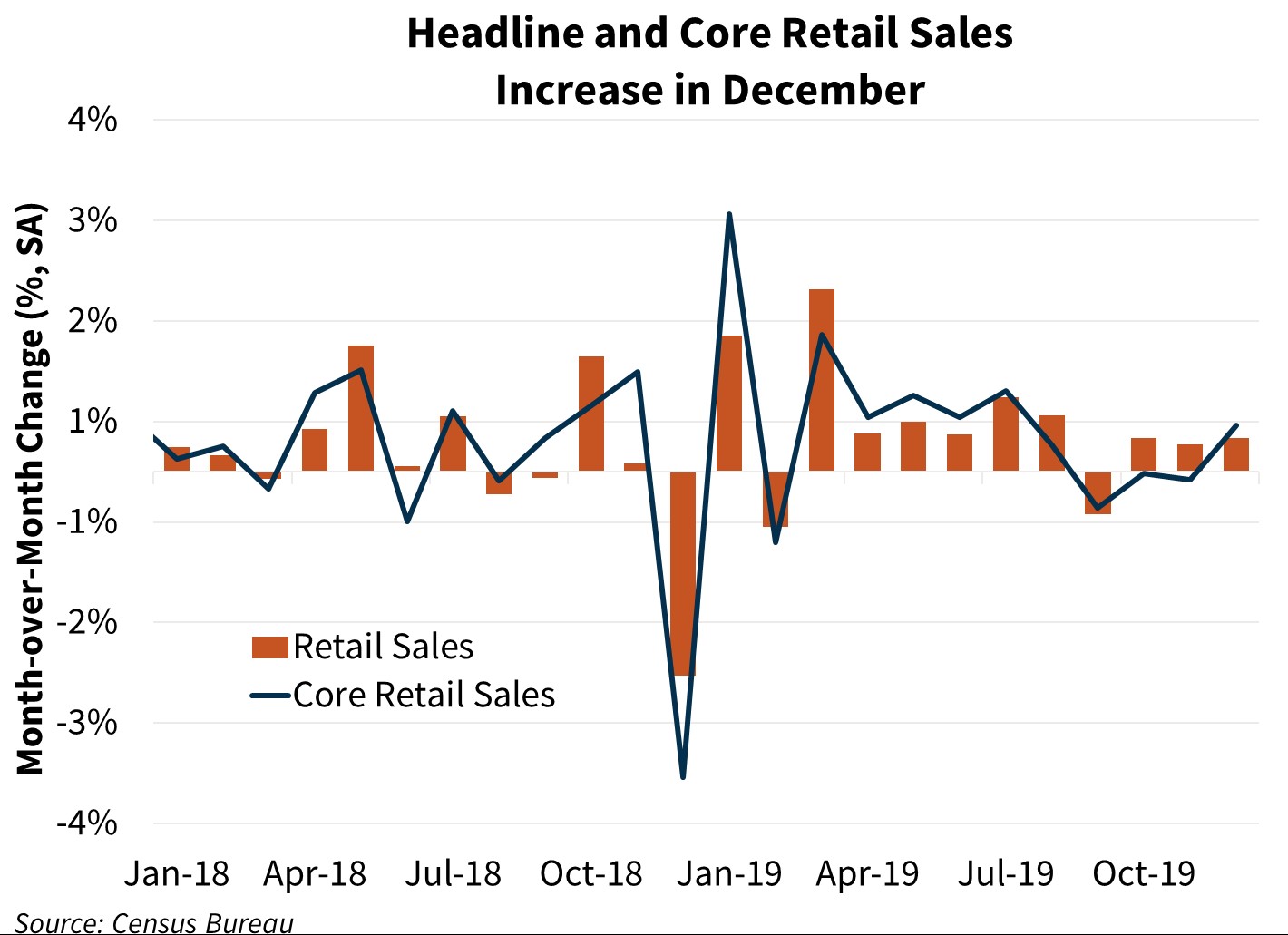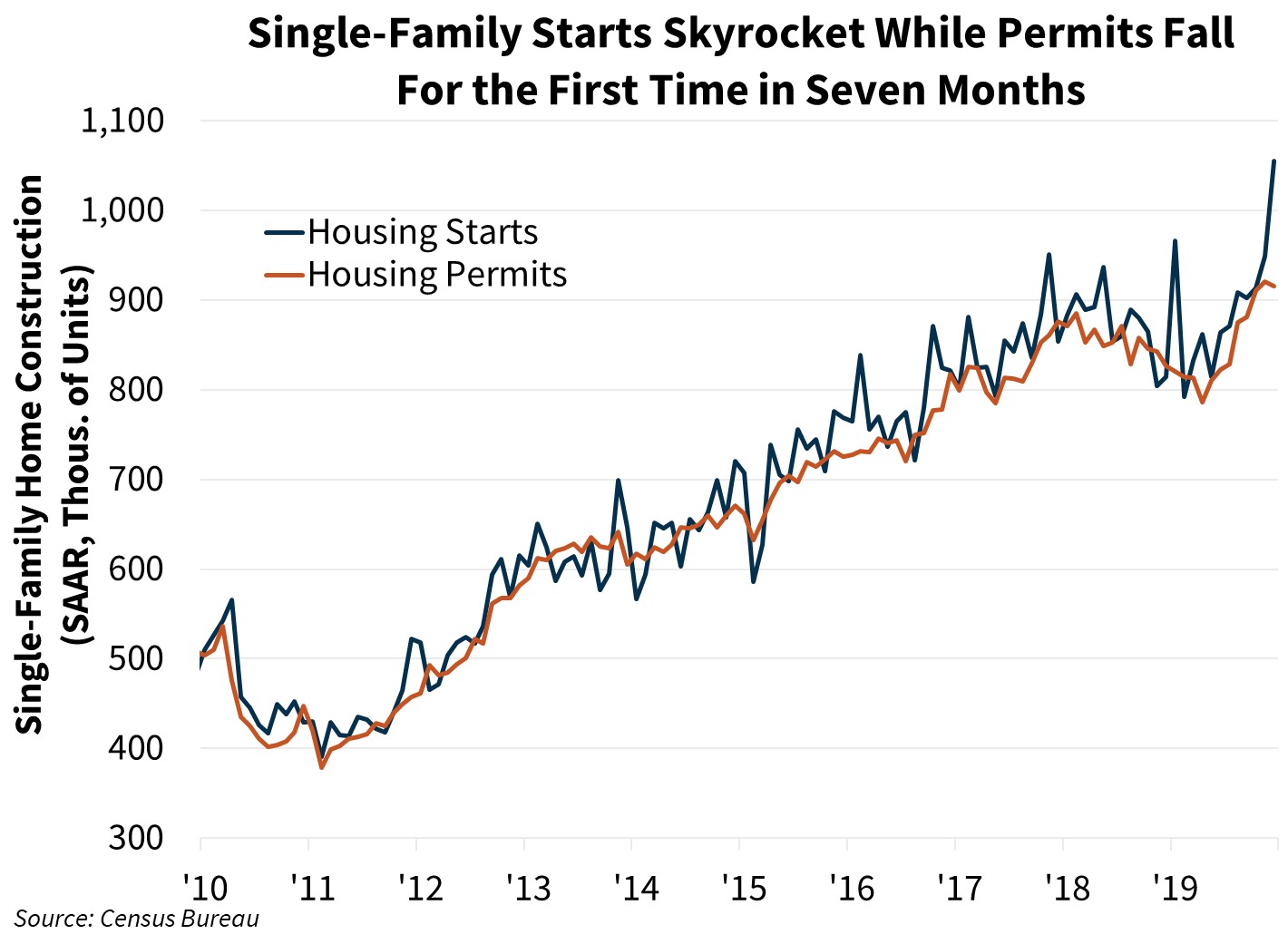Single-Family Housing Starts Breach One Million Units
Key Takeaways:
- Total housing starts jumped in December to the fastest pace in thirteen years, according to the Census Bureau, with single-family starts rising 11.2 percent to an annualized pace of 1.06 million units. Multifamily starts rose even more strongly at 29.8 percent, while both single-family and multifamily permits fell.
- Retail sales rose 0.3 percent in December, with the only weaknesses in motor vehicles & parts and department stores. Core retail sales grew by 0.5 percent, the fastest pace since July, but fell on a quarterly basis in the fourth quarter for the first time since Q2 2013 as the October and November reports were revised downward.
- Headline CPI rose 2.3 percent in December from a year earlier, the fastest pace of growth since October 2018, while core CPI also grew 2.3 percent, unchanged from last month.
- Industrial production fell 0.3 percent in December for the third time in four months, dragged down by a sharp drop in the utilities sector thanks to warmer than average weather.
Forecast Impact
Retail sales continue to underscore the current strength of consumers, suggesting that we may need to increase our December expectations for fourth quarter 2019 consumer spending; on the other hand, industrial production fell for the third time in four months in December, suggesting slightly less business fixed investment in the fourth quarter. Housing starts in December blew consensus expectations out of the water. Permits had been outpacing starts for a few months, so while the number surprised to the upside, we were expecting some amount of catch-up. The warmer weather in December also likely contributed to the increase in construction. This will lead to upward revisions to forecasts of both starts and residential fixed investment moving forward, though we do expect a moderate pullback now that a share of the previously authorized-but-not-started units has been drawn down.


Details on Key Takeaways and Other Releases
- Retail sales rose 0.3 percent in December, according to the Census Bureau, driven by sales at gas stations, clothing stores, and building supply stores, which rose 2.8, 1.6, and 1.4 percent, respectively. Excluding motor vehicles and parts, retail sales increased 0.7 percent. Core retail sales (excluding food, auto, building supplies, and gas station sales) grew by 0.5 percent, the fastest pace since July. On a quarterly basis, however, core retail sales fell in the fourth quarter for the first time since Q2 2013 due to downward revisions to core sales in both October and November.
- Housing starts skyrocketed 16.9 percent in December, rising to 1.61 million annualized units, according to the Census Bureau, the fastest pace in thirteen years. Both single-family and multifamily starts saw significant increases, rising 11.2 and 29.8 percent, respectively, with single-family starts jumping to 1.06 million annualized units and multifamily starts increasing to 553,000 annualized units. Single-family starts were 894,000 in 2019, the highest number since 2007. Single-family starts in 2019 were 2.5 percent above 2018 starts, and multifamily starts were 7.1 percent above. Single-family permits fell 0.5 percent to 916,000 and multifamily permits plunged 9.6 percent to 500,000.
- The Consumer Price Index (CPI) increased 0.2 percent in December, while core CPI (excluding food and energy prices), rose 0.1 percent. From a year ago, headline CPI rose 2.3 percent, the fastest pace of growth since October 2018, while core CPI grew 2.3 percent, unchanged from last month.
- Industrial production, a gauge of output in the manufacturing, utility, and mining sectors, fell 0.3 percent in December, according to the Federal Reserve Board. The manufacturing component edged up 0.2 percent and the mining component rose 1.3 percent, while the utilities component dropped 5.6 percent. On a year-over-year basis industrial production fell 1.0 percent. Capacity utilization decreased 0.4 percentage points to 77.0 percent.
Ricky Goyette
Economic and Strategic Research Group
January 17, 2020
Opinions, analyses, estimates, forecasts and other views of Fannie Mae's Economic and Strategic Research (ESR) Group included in these materials should not be construed as indicating Fannie Mae's business prospects or expected results, are based on a number of assumptions, and are subject to change without notice. How this information affects Fannie Mae will depend on many factors. Although the ESR group bases its opinions, analyses, estimates, forecasts and other views on information it considers reliable, it does not guarantee that the information provided in these materials is accurate, current or suitable for any particular purpose. Changes in the assumptions or the information underlying these views could produce materially different results. The analyses, opinions, estimates, forecasts and other views published by the ESR group represent the views of that group as of the date indicated and do not necessarily represent the views of Fannie Mae or its management.
